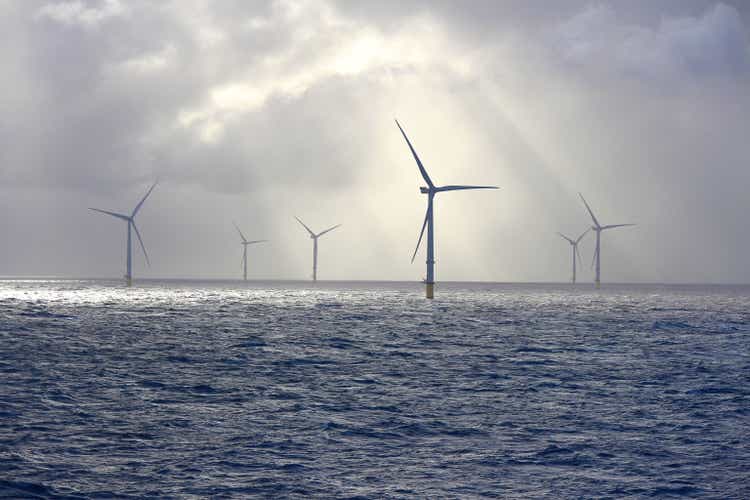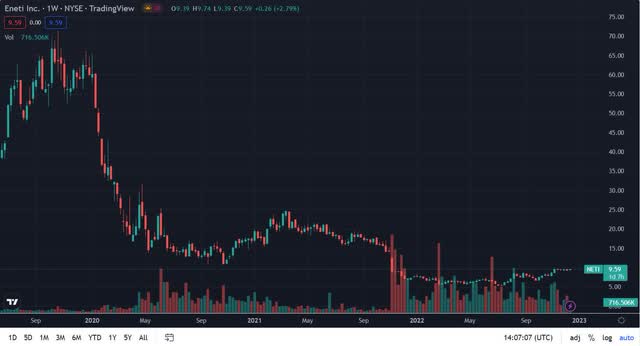glegorly
After reaching a 2-year high of approximately $24.50 on March 15, 2021, the share price of wind turbine installer Eneti Inc. (NYSE:NETI) has collapsed, falling to a 52-week low of $4.81 on July 11, 2022, before more than doubling to its 52-week high of $9.80 per share on November 14, 2022.
Since then, it has pulled back to trade in a range of about $9.00 per share to around $9.70 per share, suggesting the stock is looking for direction with much of the potential near-term growth of the company appearing to be already priced in.
Demand for marine wind turbine installation continues to grow, which has resulted in a contracted backlog of $283 million at the end of the last quarter for NETI. Two of its installation vessels are already contracted through the end of 2023.
With significant barriers to entry, growing demand, and the company having two vessels under construction that will have the capacity to install the next generation of wind turbines, NETI is positioned well for long-term growth.
In this article we’ll look at some of the numbers from its latest earnings report, the short-term possibility of a correction, the future or wind turbine growth, and why NETI is going to be a leading supplier of marine wind turbine installation through the end of the decade.
Some of the numbers
Revenue in the third quarter was $69.2 million, up $8 million sequentially, and the highest quarterly revenue in the company’s history as a wind turbine installation firm. That was a little over double the $34.4 million in revenue reported in the third quarter of 2021.
Net income in the reporting period was $36.2 million, or $0.95 per share. Approximately $8.1 million or $0.22 per diluted share of that came from its investment in Scorpio Tankers Inc., which was sold during the reporting period.
The company had a net loss in the quarter of $0.9 million, or $0.06 per diluted share.
EBITDA in the third quarter was $45 million, up almost $31 million from the $14.1 million in EBITDA produced in the third quarter of 2021.
For the first nine months 2022, the company generated net income of $93.1 million, or $2.41 per diluted share. That included the approximate $54.9 million in gains or $1.44 per diluted share, from its equity position in Scorpio Tankers Inc. EBITDA in the first nine months of 2022 was $119.4 million, compared to the $85.8 million in EBITDA generated in the first nine months of 2021.
At the end of the third quarter the company held unrestricted cash of $133.4 million.
Vessels under construction
In response to growing demand and low supply of vessels in the rapidly growing offshore wind turbine market, NETI has contracted with Daewoo Shipbuilding and Marine Engineering to construct “two next-generation offshore wind turbine installation vessels (“WTIV”)” for a price of about $654.8 million, of which it has paid approximately 10 percent on at this time.
The first vessel should be delivered sometime in the third quarter of 2024, and the second vessel is scheduled to be delivered in the second quarter of 2025.
When the vessels are delivered, they’ll be among the top-end vessels in the sector. That’s significant because the trend among offshore wind turbine demand is for larger turbines to be installed, which requires the type of vessels NETI is having built for it; included with the vessels will be 2,600-ton cranes that will have the capability of installing next generation turbines.
Based upon the assumed tightness of vessel supply in the second half of the decade, NETI will be positioned to not only use its current vessels to meet regular demand, but also to meet the growing demand for larger turbine installations.
The company states that with the expected shortage of vessels clients are looking to secure capacity before demand significantly outstrips supply.
While that sounds good, I would like to hear of contractual confirmation on that, as well as what the utilization and day rates are, especially with the new vessels under construction. If the scenario presented by the company plays out in the offshore wind turbine market, then it could easily outperform in the latter half of the decade, as demand ramps up.
On the other hand, if the demand doesn’t increase at expected levels, the $654.8 million investment made in the two vessels would be a huge headwind for NETI. Not only that, but it would be a headwind for its other vessels as well, which need to be in service in order to generate revenue.
Another thing I’m not sure about is whether or not the $654.8 million could move up in a big way from rising material costs. If costs increase, it will reduce the potential profits the company is looking for.
Macro-economics and spend
When looking at companies like NETI that operate in the green sector, expectations are there aren’t likely to be much in the way of disruptions that could impact the company. Yet look at the solar industry and how that has ebbed and flowed through the years, with a large number of companies underperforming.
With that in mind, the current macro-economic environment could slow down spend on these types of projects if governments get strapped for cash. In some cases, they could even be put on long-term hold, or abandoned altogether.
If the recession gets worse and deeper for longer than expected, it would definitely be a disruptive force in the time frame assumptions NETI is operating under.
Another thing to consider is backlog doesn’t necessarily equate with guaranteed business. Many companies in different sectors that compete for government contracts find themselves disappointed when funding is slow to come, or projects are significantly delayed; things like that happen all the time.
I don’t think it’s likely that the offshore wind turbine industry is going to collapse over the long term, but in the near term there are a lot of headwinds that could emerge that would slow things down.
The point of all this is with the large investment NETI has made in the two vessels, anything that would slow things down in the sector for a prolonged period of time would hit the company hard.
That said, if things go according to plan with few major hiccups, NETI will be positioned in the second half of the decade to sustainably grow over a period of years.
The barrier to entry is the capital and time it takes to buy or build enough vessels to serve the offshore turbine market. With NETI, if the two vessels are constructed on time and there is nothing at the macro-level that disrupts the industry, it’s going to be a market leader in the sector.
Under normal industry conditions increasing the supply of ships is a challenge, but with demand ramping up, the shortage of vessels will result in pricing power for the companies like NETI that are preparing to meet that demand in a tightening supply market.
Conclusion
Most analysts consider the offshore wind turbine industry to be one of long-term growth, and even though there are differences of opinion on the pace of the growth, there is a general consensus that future growth in the sector will be strong. I believe that’s true, with the caveat that a lot of things can happen to disrupt short-term growth and results that are out of the company’s control.
Bringing everything together, I think that after its big upward run since July, a lot is already priced in for NETI. For that reason, I lean toward the company correcting and possibly consolidating heading into 2023.
There will be more interest rate hikes and stubbornly high inflation, even it starts to gradually go down. If the recession gets worse, then the company will take a hit like most other companies will, even if the long-term prognosis for the company remains healthy.
With its current fleet and visibility, I’m not seeing what positive catalyst would emerge that would drive the share price up much higher on a sustainable basis.
For that reason, I would wait for a pullback if considering taking a new position in the company because the upside is limited.
For longer term investors that already have a position in the company, I would buy on dips because of the high percentage chance NETI will perform well through the end of the decade.
Nothing is for sure, but I personally like the odds, even if there are some temporary headwinds that put downward pressure on the stock.



Be the first to comment